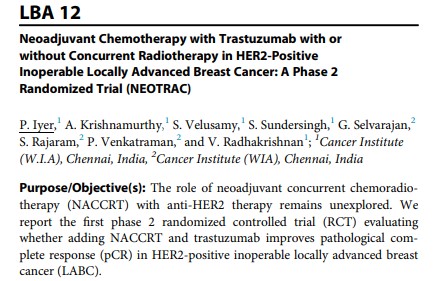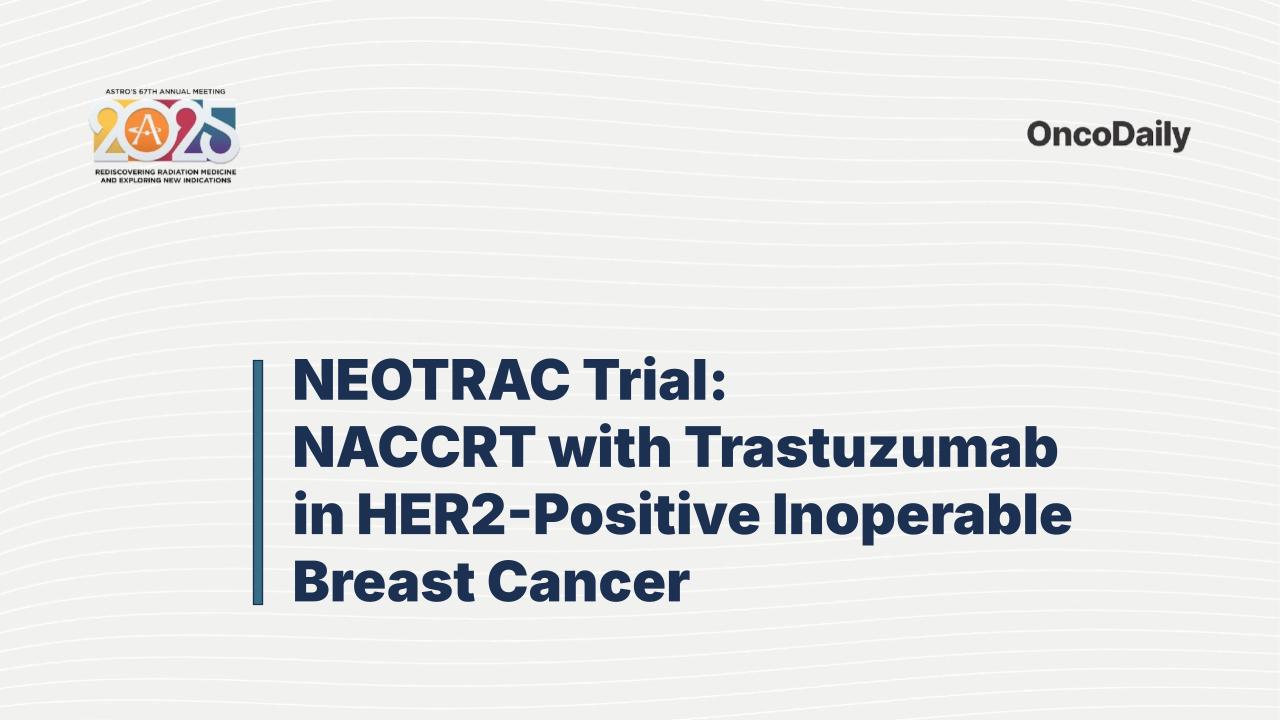Auhtors: P. Iyer, A. Krishnamurthy, S. Velusamy, S. Sundersingh, G. Selvarajan, S. Rajaram, P. Venkatraman, and V. Radhakrishnan
The phase II NEOTRAC trial is the first randomized study to evaluate neoadjuvant concurrent chemoradiotherapy (NACCRT) combined with trastuzumab for HER2-positive inoperable locally advanced breast cancer (LABC).
Study design
The trial enrolled 118 patients with newly diagnosed, stage III HER2-positive inoperable LABC. Participants were randomized 1:1 to receive either neoadjuvant chemotherapy (NACT) with trastuzumab (Arm A) or NACCRT plus trastuzumab (Arm B). Both arms received four cycles of Adriamycin and Cyclophosphamide followed by four cycles of Paclitaxel, along with nine weekly cycles of trastuzumab.
In Arm B, concurrent radiotherapy (46 Gy to the breast and nodal regions) was delivered alongside paclitaxel and trastuzumab prior to mastectomy. In Arm A, postmastectomy radiotherapy (50 Gy) was delivered following surgery. Adjuvant trastuzumab was continued for one year in both arms. The primary endpoint was pathological complete response (pCR), while secondary endpoints included overall and event-free survival, toxicity, and total treatment duration.

source: www.astro.org
Results
Out of the 118 enrolled patients, 113 underwent surgery, with a median age of 50 years and all presenting with stage III disease. In terms of pathological response, pCR rates were 46.6% in Arm A and 50.9% in Arm B, a difference that was not statistically significant (P=0.64), and remained consistent across subgroups including hormone receptor status, menopausal status, tumor size, and stage.
At a median follow-up of 27 months, survival outcomes were similar between the two groups. Event-free survival was 81.0% in Arm A versus 81.9% in Arm B (P=0.79), and overall survival was 93.0% versus 95.1% (P=0.88), respectively. Notably, the addition of concurrent radiotherapy in Arm B significantly reduced total treatment duration, with a median of 189 days compared to 255 days for Arm A (P<0.00001).
Toxicity profiles were generally manageable. Surgical wound morbidity was higher in Arm B at 16.4% versus 6.9% in Arm A, although this difference was not statistically significant (P=0.15). Grade 3 radiation dermatitis occurred in 5.5% of patients in Arm B, and grade 3 neutropenia in 3.6%; importantly, no cardiac toxicity was observed in either arm. Among the few patients achieving a clinical complete response who declined surgery, only one patient in Arm A progressed, while the remaining patients in both arms remained disease-free.
Takeaway
The NEOTRAC trial demonstrates that NACCRT with trastuzumab is a feasible and well-tolerated approach in HER2-positive inoperable LABC. While pCR was slightly higher with NACCRT, the difference was not statistically significant, indicating that adding concurrent radiotherapy does not markedly change immediate pathological outcomes. However, NACCRT substantially shortened total treatment duration, offering practical benefits in reducing hospital visits and potential socioeconomic burden. Toxicity was acceptable and cardiac safety was maintained.
These results suggest that NACCRT may be a viable option for patients seeking shorter, efficient neoadjuvant therapy, particularly in healthcare settings where minimizing treatment duration is important. Further studies are warranted to assess whether the benefits of shortened treatment with NACCRT can translate into improved long-term survival and quality of life.
Read More ASTRO 2025 Late-Breaking Abstracts Here
Written By Aren Karapetyan, MD
